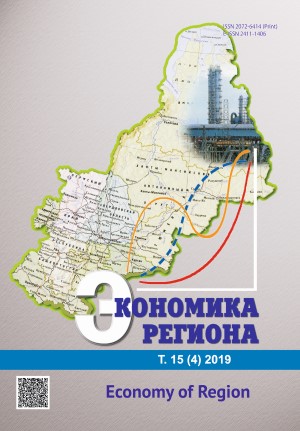ИНДИКАТИВНАЯ МОДЕЛЬ ОЦЕНКИ ПОКАЗАТЕЛЕЙ БАЛАНСА ТРУДОВЫХ РЕСУРСОВ МУНИЦИПАЛЬНЫХ ОБРАЗОВАНИЙ РЕГИОНА
Indicative Model for Assessing the Balance Indicators of the Labour Forces in the Region’s Municipalities
Author(s): Olga Efimovna Podverbnykh, Svetlana Mikhailovna SamokhvalovaSubject(s): Economy
Published by: Институт экономики Уральского отделения Российской академии наук
Keywords: economy of municipalities; municipal statistics; regional development; the balance of the labour forces; specific features of the social and economic conditions; open statistical data
Summary/Abstract: A high level of the economic potential’s heterogeneity, precarious climatic conditions led to the distortion of the life’s quality and depopulation of many local territories of Krasnoyarsk Krai and other Russian regions. The spatial disproportion of the labour forces hinders national plans for harnessing the unique potential of Eastern Siberia and Arctic. The accuracy and efficiency of the regional economy’s regulation is ensured by the sufficient and coherent local analytical data about the balance of the labour forces’ demand and supply. However, assessment of the balance of the municipalities’ labour forces remains an open research question. This is due to the advantages of two-level spatial planning, insufficient connection between municipal and regional strategic decisions, limited municipal statistics. We assessed the balance of the municipality’s labour forces in order to theoretically substantiate and develop the indicative model for assessing the balance indicators of the labour forces in terms of the local territories. We formed the concept of the indicative balance model considering the specific features of the territories’ social and economic conditions. Moreover, we substantiated a methodology for assessing the balance indicators of the municipalities’ labour forces. Additionally, we developed a mathematical model of the indicative assessment of such forces, demonstrated an analytical database of the assessment data, and a software package for its calculation. We tested the model and calculated the balance of the labour forces for 61 municipalities of Krasnoyarsk Krai. We assessed the force indicators using three standard allregional coefficients: coefficient of the working population of working age; coefficient of the foreign working migrants; coefficient of the population above working age and teenagers, employed in the economy. We calculated the differentiation of all-regional values by considering the specific rates, such as dependency ratio coefficient, employability coefficients, coefficients of the manufacturing development. The model’s testing allowed us to draw conclusions on the dynamics of demands and the achieved potential of the municipal labour forces’ development. Furthermore, we have discovered the growth zones and critical points of decline. The model can be used for shaping the strategies at the municipal, regional and macro-regional levels.
Journal: Экономика региона
- Issue Year: 15/2019
- Issue No: 4
- Page Range: 1141-1155
- Page Count: 14
- Language: Russian

